Ideal Therapy Aids Motor Skills and Breathing, Taken Orally: UK Survey

Motor function and stabilizing or improving breathing — along with oral administration — are the factors that adult patients and caregivers of children with spinal muscular atrophy (SMA) type 2 or 3 who cannot walk value most when deciding on available treatments, a U.K. survey study shows.
Avoiding longer-lasting adverse reactions was also important to caregivers, but less so among adult patients.
These findings shed light on the trade-offs patients and caregivers are willing to make in terms of treatment attributes, and add to similar results from a previous U.S. study involving a broader patient population.
Together, the data emphasize that treatment choices should not be guided by effectiveness alone, the researchers noted.
The study, “Preferences and Utilities for Treatment Attributes in Type 2 and Non-ambulatory Type 3 Spinal Muscular Atrophy in the United Kingdom,” was published in the PharmacoEconomics.
Currently, three disease-modifying therapies are available for SMA: Biogen’s Spinraza (nusinersen), Novartis’ gene therapy Zolgensma (onasemnogene abeparvovec-xioi), and Roche’s Evrysdi (risdiplam).
While they all work to restore the levels of SMN — the protein lacking in SMA patients — they do so through different mechanisms, are delivered through distinct routes and regimens, and have different safety profiles.
Spinraza is injected directly into the spinal canal three times a year, Zolgensma is administered through a single into-the-vein infusion, and Evrysdi is taken daily as an oral solution.
As such, patients, as well as their caregivers and healthcare providers, have to make treatment choices. These decisions, when not limited by eligibility criteria, are likely based on preferences for specific treatment attributes and trade-offs among them.
A previous U.S. study showed that caregivers of pediatric patients and patients with any SMA type and level of motor function “placed high value on treatments that improve motor and breathing function, an indication across all ages, oral or one-time infusion, and minimal risk profiles,” the researchers wrote.
Now, researchers at Roche and Acaster Lloyd Consulting evaluated SMA treatment preferences in the U.K. in a more limited patient group — those with SMA type 2 or 3 who are non-ambulatory — and considering specific safety issues associated with Spinraza and Evrysdi. Members of the general public were also recruited to take part.
The study did not include attributes associated with Zolgensma, which is available to a minority of this patient group.
Researchers also estimated SMA-related health utilities, which are cardinal values of health states that may be experienced by patients.
Health utilities can be used to estimate patients’ health-related quality of life and thereby treatment impact, which help to guide funding decisions in countries with publicly funded healthcare systems, such as the U.K.
The researchers conducted two discrete choice experiment surveys: one to assess treatment preferences, and the other for the health utilities analysis. This type of survey is increasingly used in healthcare to elicit preferences from responders, including treatment features, without directly asking them to state their preferred options.
Survey participants were presented with a series of scenarios and asked to choose between sets of two hypothetical medications with varying features, forcing them to distinguish their preferences for the features given in each choice scenario.
Varying features included treatment outcomes like motor function and breathing; delivery mode; adverse events, or side effects like fever, headache, vomiting, and body pain; monitoring, contraception (patients only), and overall survival (general public only).
The first survey was completed by 84 adult patients (mean age of 33.9) and 83 caregivers of pediatric patients (mean age of 8.4), recruited through TreatSMA and SMA UK.
Most patients (73%–92%) in both groups had type 2 disease. Most children could sit independently and about half needed some ventilatory support, while adults most commonly sat with support and relied less often on breathing assistance (27%).
Nearly two-thirds (65%) of pediatric patients and one adult patient had been treated with Spinraza. Most (69%) adult patients were under no treatment for their SMA.
Adult patients were twice as likely to favor a treatment that improved (versus stabilized) their motor or breathing functions, while caregivers were three to nine times more likely to favor motor function improvement, results showed.
A treatment linked with a worsening (versus stabilization) of motor or breathing functions was four to five times less preferred by adult patients, but only four times less favored by caregivers.
These findings highlight that caregivers “were more willing to make trade-offs to improve motor function and — to a lesser extent — breathing function, while adult patients focused more on avoiding deterioration in breathing function and motor function,” the researchers wrote.
Adult patients “may place relatively greater value on stabilization, as it can enable them to maintain autonomy and could therefore be perceived as a marker of treatment success,” they added.
Both patients and caregivers were two to three times more likely to prefer a daily oral treatment over spinal canal, or intrathecal, injections three times a year.
While treatment reactions were not important to adult patients, caregivers preferred to avoid adverse events that lasted three to four days, while being less concerned with those lasting one to two days.
Treatment choices of both patients and caregivers were not driven by avoiding either monitoring or contraception.
The second survey, meant to estimate SMA-related health utilities, was completed by 506 adults who were representative of the U.K. general public.
Results showed that health utility values significantly fell with worsening motor and lung function, and, to a lesser extent, with intrathecal treatment and adverse events. This emphasized the value of maintaining an ability to sit and breathe without mechanical ventilation, and of avoiding spinal canal injections and treatment reactions.
These findings highlight “the value that caregivers and adult patients place on motor function, breathing function and oral administration in the context of SMA treatments,” the researchers wrote, adding that health-disutilities (reductions in utility) generated from the general public “were substantial for SMA disease outcomes and care aspects.”
Data also suggest that treatment choices “should not be guided by clinical effectiveness only but be guided by many factors,” as both patients and caregivers “valued the avoidance of intrathecal injection and caregivers preferred for their children to avoid longer-lasting treatment reactions,” the team added.
“The caregiver, patient and general public preference data can also be used to inform national-level decision-makers who are concerned with understanding the value of improvements in treatment,” the researchers concluded.
Three of this study’s six authors are employees of Roche and one is a former employee; the company sponsored this work.








